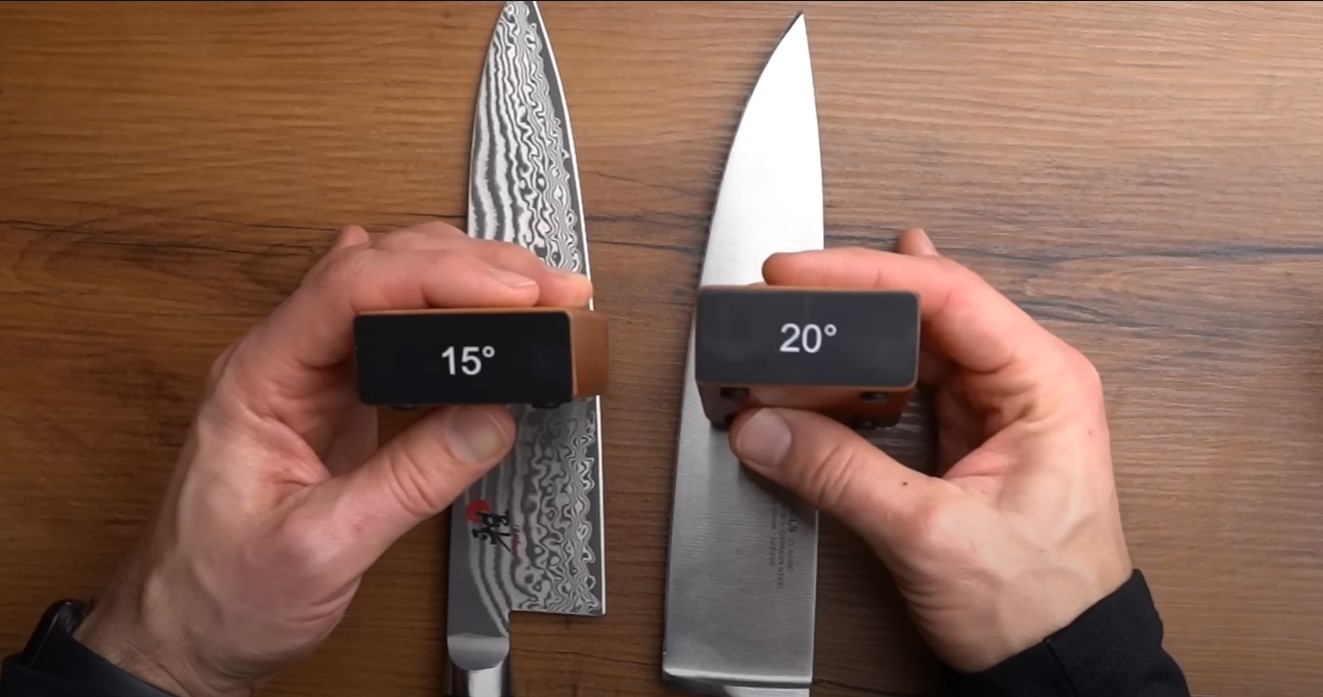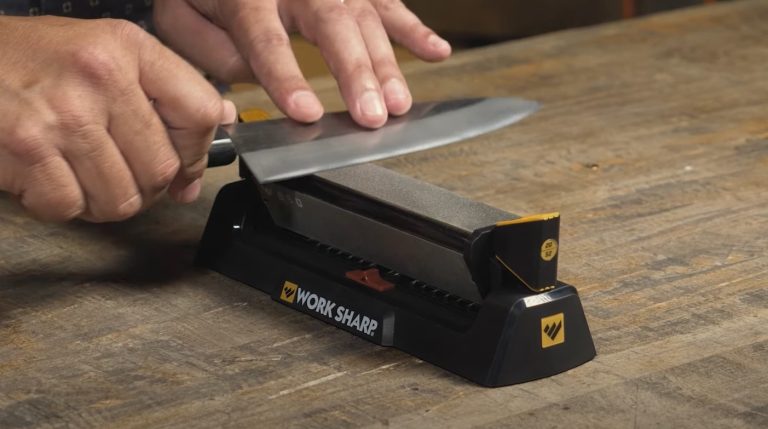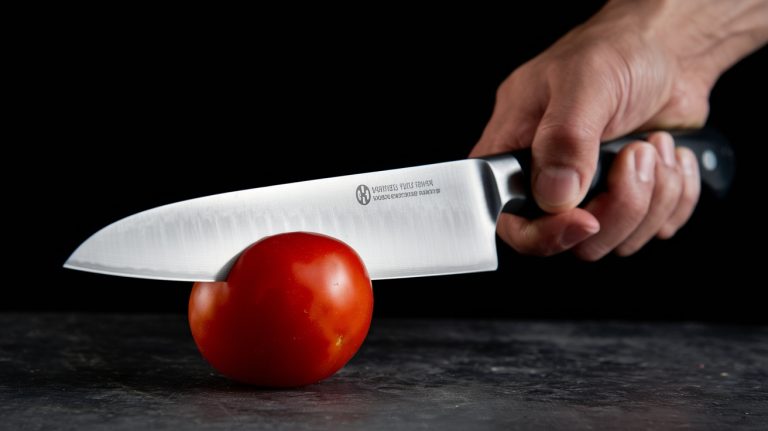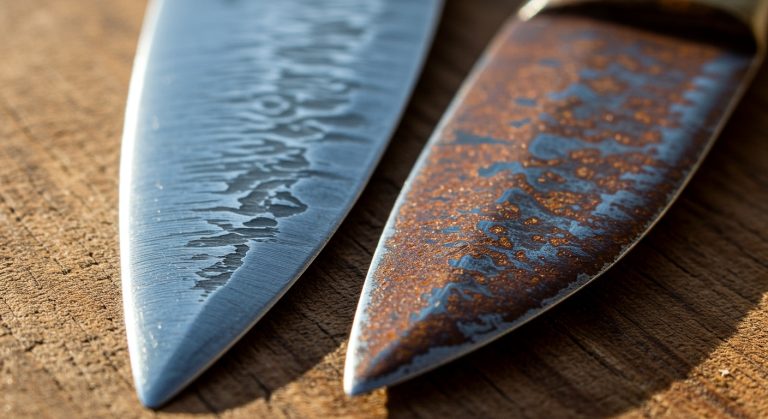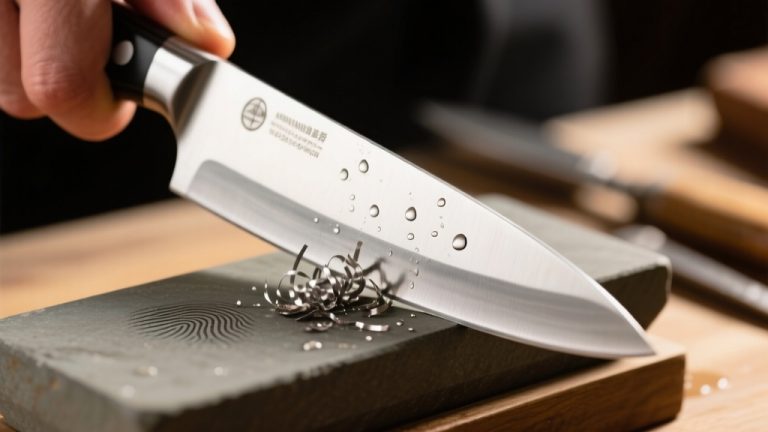Best Knife Sharpening Angle Guide: Unlock Peak Performance
To get the best performance from your knives, focus on the right sharpening angle. For a Japanese knife, aim for 15 degrees, while Western knives typically do well at 20 degrees.
Kitchen and pocket knives generally perform best at angles between 17 to 20 degrees. If you’re sharpening heavy-duty or hunting knives, consider 20 to 30 degrees for added durability. Keep a consistent angle during sharpening to maintain peak sharpness and edge retention.
By understanding how knife type and steel composition influence the ideal angle, you’ll enhance your sharpening technique there’s much more to explore.
Key Takeaways
- For Western knives, a sharpening angle of 20 degrees per side balances sharpness and durability effectively.
- Japanese knives perform best with a 15-17 degree angle for superior edge sharpness.
- Use lower angles (10-15 degrees) for precision tasks and higher angles (20-30 degrees) for heavy-duty applications.
- The steel composition influences angle choices; softer steels can handle lower angles, while harder steels require higher angles.
- Regular maintenance and consistent angle during sharpening are crucial for optimal edge performance and longevity.
About Sharpening Angles
When you sharpen a knife, the angle at which you do so plays a crucial role in determining its performance and longevity.
The sharpening angle refers to the degree between the knife’s edge and the sharpening stone, measured per side. Most knives feature a bevel on both sides, effectively doubling the total angle.
Different knife types require specific angles; for instance, Japanese knives typically sharpen at 15 degrees for high sharpness, while Western knives prefer 20 degrees for a balance of durability and sharpness.
Standard angle for American/European knives is generally 20 degrees, making it an excellent starting point for those uncertain about their knife’s steel type. Maintaining a consistent angle is crucial for achieving optimal sharpness and edge retention.
Lower angles create sharper edges but reduce durability, whereas higher angles enhance durability at the expense of sharpness.
Understanding these basic principles will guide you in achieving ideal edge performance tailored to your knife’s intended use.
Choosing the Right Angle
Choosing the right sharpening angle is essential for optimizing your knife’s performance.
You’ll need to take into account the type of knife, the hardness of the steel, and the intended use to determine the best angle. Each factor influences how the blade will perform and how often it will need maintenance.
For example, understanding the optimal sharpening angles based on the knife type can significantly enhance its effectiveness and longevity. Additionally, maintaining a sharp edge through regular inspections can prevent the need for frequent sharpening.
Knife Type Considerations
Different knife types require specific sharpening angles to optimize their performance and longevity.
For Western knives, a 20-degree angle per side balances sharpness and durability. Japanese knives, however, perform best at 15-17 degrees per side, offering exceptional edge sharpness. Understanding the optimal sharpening angle is crucial for achieving the best results.
Pocket and outdoor knives typically follow the 20-degree standard for versatility. Single bevel knives, common in traditional Asian designs, are sharpened on one side, while double bevel knives feature angles on both sides.
Kitchen knives generally fall within 17-20 degrees, while hunting knives may require higher angles (22-30 degrees) for durability.
Straight razors demand extremely low angles (7-8 degrees) for precision, whereas filleting knives benefit from even lower angles (10-15 degrees) for smooth cuts.
Steel Composition Impact
Understanding the impact of steel composition on sharpening angles is vital for achieving ideal knife performance.
For steels like 52100 and AEB-L, with a low volume of small carbides, a sharpening angle of around 10 degrees per side (dps) is most effective, typically ranging from 8-12 dps. Thinner edges (12-17 degrees per side) are preferred for certain PM steels, enhancing cutting performance.
Conversely, traditional steels such as ATS-34 and D2, which have large carbides, require a higher angle of about 25 dps, ideally between 20-30 dps, to maintain edge stability.
Meanwhile, PM steels with small carbides can be sharpened at approximately 16 dps, within a 12-20 dps range.
Supersteels offer flexibility, allowing angles as low as 11-12 dps, but not as acute as common steels.
Matching the angle to the steel type is essential for performance.
Usage Purpose Analysis
When selecting the right sharpening angle for your knife, it’s crucial to take into account the intended usage, as the angle directly influences performance. Different tasks require specific angles for ideal results:
| Usage Purpose | Recommended Angle |
|---|---|
| General Kitchen Use | 17 to 20 degrees |
| Precision Slicing | 12 to 17 degrees |
| Tougher Tasks (Hunting) | 20 to 25 degrees |
| Japanese Knives | 15 degrees |
Lower angles yield sharper edges, while higher angles provide greater durability. The balance between hardness and toughness is essential in determining the optimal sharpening angle for your knife.
Always consult the manufacturer’s guide and adjust the angle based on your knife’s performance over time. This guarantees you maintain both sharpness and edge retention for your specific cutting tasks.
Determining the Correct Angle
How can you determine the correct sharpening angle for your knife?
Start by identifying the knife type; Japanese knives typically require a 15-degree angle, while Western knives need around 20 degrees. Cutting edge angles vary, and smaller angles yield sharper knives.
Consider the knife’s intended use lower angles enhance slicing, while higher angles improve chopping durability.
Assess the steel hardness; harder steels can handle lower angles for sharper edges, but may be more brittle.
Use practical methods like the pen trick or folding paper to gauge angles.
Manufacturer guides often provide specific recommendations, so consult those for accuracy.
Sharpening Techniques
Mastering sharpening techniques is essential for maintaining your knives’ performance and longevity. You’ll want to follow a systematic approach using sharpening stones.
| Step | Description |
|---|---|
| 1. Setup | Soak the stone, apply water or oil, and position the knife at a consistent 15-20 degree angle. |
| 2. First Side | Drag the knife towards you, maintaining pressure until a burr forms. Check for the burr on your thumb. |
| 3. Second Side | Position the blade at the same angle and push it away from you, repeating until you form a burr. |
| 4. Refining | Use finer grits to polish the edge, testing sharpness on paper. For a mirror finish, go up to 2000 grit or higher. |
Regular maintenance of your sharpening stones is crucial as it prolongs the life of the sharpening stone.
Common Sharpening Angles
When sharpening knives, understanding the common angles is essential for ideal performance.
Standard American and European knives typically require a 20-degree angle, while Japanese knives perform best at 10-15 degrees. Proper sharpening angles are crucial for ensuring that knives maintain both sharpness and durability.
For heavy-duty options, you might consider adjusting these angles to enhance edge durability while maintaining sharpness.
Standard Knife Angles
Understanding standard knife angles is essential for achieving ideal sharpness and durability in your blades. Generally, knife angles range from 15 to 30 degrees.
A typical angle for most kitchen knives is around 20 degrees, striking a balance between sharpness and durability. Choosing the right angle is crucial for knife sharpening success.
Here’s a quick reference table for standard knife angles:
| Angle Range | Common Use |
|---|---|
| 10 to 15 degrees | Fine edges, delicate tasks |
| 15 to 20 degrees | Most kitchen and pocket knives |
| 20 to 30 degrees | Heavy-duty knives and tools |
| 22 to 30 degrees | Specialized, heavy-duty tasks |
Japanese Knife Angles
Japanese knives typically feature sharpening angles of 15 degrees on each side, striking an ideal balance between sharpness and durability. This precise angle guarantees a keen edge suitable for delicate tasks like slicing and dicing.
The use of harder steels in Japanese knives enhances their ability to maintain a sharp edge over time.
For double-bevel knives, you’ll sharpen both sides at this angle, while single-bevel knives have unique requirements. The harder steels used in Japanese knives complement this sharpness, allowing for long-lasting performance.
When sharpening, start with a rough grit stone (Arato) to repair the edge, then move to a medium grit stone (Nakato) for refining, and finish with a fine grit stone (Shiageto) for polishing.
Regular maintenance with honing rods will help preserve the edge, guaranteeing your knife remains efficient and effective.
Heavy-Duty Knife Angles
While Japanese knives excel in precision tasks with their fine angles, heavy-duty knives demand a different approach to sharpening. For peak performance in heavy-duty applications, aim for sharpening angles between 21° and 25°.
A standard angle of 21° is often ideal for pocket knives, providing a robust edge suitable for tasks like processing wood. Higher angles typically range from 25° to 30° and are recommended for heavy-duty use, ensuring stronger edges that can withstand demanding tasks.
Western-style knives typically range from 15° to 20° for general use, but for heavy-duty tasks, you should also increase the angle to 21° or higher.
Tips for Sharpening
Sharpening your knives effectively can greatly enhance their performance and longevity. Here are some essential tips to keep in mind:
| Technique | Description |
|---|---|
| Light Pressure | Apply light but firm pressure during sharpening. |
| Consistent Angle | Maintain the same angle on every stroke. |
| Burr Removal | Gently press the edge to the stone to remove the burr. |
Regular maintenance is key; sharpen your knives before they become too dull. Sharp knives improve safety and efficiency in cutting tasks, making it even more crucial to keep them in optimal condition.
Keep them clean and dry, and use wooden cutting boards to avoid damaging the edges. For better control, place your index finger on the spine and use your other fingers to grip the handle.
Angle Variations for Knife Types
Understanding the appropriate sharpening angle for different types of knives is essential for achieving ideal performance and longevity.
For kitchen knives, aim for 17 to 20 degrees per side, balancing sharpness and durability. If you’re using western knives, a 20-degree angle enhances versatility, while Japanese knives benefit from sharper edges at 15 to 17 degrees. Additionally, knife design plays a significant role in determining the most effective angle for performance.
Pocket knives require slightly steeper angles, typically 20 to 22 degrees, for rugged durability. Hunting knives should be sharpened at 22 to 30 degrees to withstand heavy-duty tasks.
For specialized tools like Japanese single bevel knives, maintain 15 to 17 degrees on one side.
Always remember: lower angles yield sharper edges, but at the expense of durability. Choose wisely for your knife’s intended use.
Impact of Steel Composition
The composition of the steel greatly influences a knife’s performance, particularly regarding edge stability and the choice of sharpening angle.
Steels with large carbides, like D2 or 440C, necessitate higher angles (20-30 degrees per side) for stability. In contrast, steels with smaller carbides, such as PM steels, can be effectively sharpened at lower angles (12-20 degrees).
Mainstream steels with low carbide content, like 52100, work well at angles between 8-12 degrees.
It’s essential to take into account that larger carbides weaken the steel matrix at lower angles, leading to instability, while smaller carbides allow for sharper edges without compromising strength.
Customizing Your Sharpening Angle
When customizing your sharpening angle, it’s crucial to take into account the specific knife type and its intended use.
For Western-style chef’s knives, aim for 17-20 degrees per side to strike a balance between sharpness and durability. A sharpening angle that is too shallow can lead to quicker dulling of the blade.
Japanese-style knives, like Gyutou, benefit from a sharper angle of 15-17 degrees for precision slicing.
If you’re sharpening butcher knives, opt for 20-22 degrees for cutting through meat and bones effectively.
Utility folding knives should be sharpened at 22-25 degrees for enhanced edge retention, while skinning knives should range from 18-22 degrees.
Frequently Asked Questions
Can I Use the Same Angle for All My Knives?
Imagine a row of knives, each gleaming with purpose.
You can’t use the same angle for all your knives; it just won’t work. Each knife’s design and intended use demand specific angles for ideal performance. A chef’s knife thrives at around 20 degrees, while a precision razor needs a sharper edge at 10 degrees.
Ignoring these differences could dull your knives or wear them unevenly, leaving you frustrated in the kitchen.
How Often Should I Sharpen My Knives?
You should sharpen your knives based on their usage. For regular use, aim to sharpen them 1-2 times a year.
If you use them daily, sharpen every 1-2 months, and for occasional use, every 2-3 months.
Watch for signs of dullness, like difficulty cutting through simple tasks.
What Tools Do I Need for Sharpening?
To sharpen your knives effectively, you’ll need a few essential tools. Start with whetstones in various grits for coarse and fine sharpening.
A honing rod helps refine edges, while electric sharpeners offer convenience. Consider a leather strop for polishing.
If you prefer manual options, diamond or ceramic sharpeners give you control. Finally, having angle guides guarantees you maintain consistent angles throughout the sharpening process, maximizing your knife’s performance and longevity.
Is It Possible to Over-Sharpen a Knife?
Imagine sharpening a blade until it’s as thin as a whisper; that’s when over-sharpening kicks in.
Yes, it’s possible to over-sharpen a knife, and doing so can harm its performance and lifespan. Excessive sharpening wears down the material, making the edge brittle and prone to chipping.
To keep your knife cutting smoothly, hone regularly and maintain a consistent angle, preventing the need for aggressive sharpening that leads to over-sharpening.
What Are Signs That My Knife Needs Sharpening?
To determine if your knife needs sharpening, look for visual signs like a shiny, rounded edge or visible nicks.
Notice how it performs; if you struggle to cut through soft foods or find it slipping off surfaces, it’s time to sharpen.
Try the tomato and paper tests if the knife tears instead of slicing cleanly, it’s dull.
Regular maintenance is key, so keep an eye on these indicators to guarantee peak cutting performance.
Achieve Consistent Sharpness with Precision Angles
In sharpening your knife, think of it like tuning a musical instrument; even a slight adjustment can greatly enhance performance.
By understanding and applying the right angles tailored to your knife’s purpose and steel composition, you’ll achieve a razor-sharp edge that sings through your cutting tasks. Remember, consistency is key.
With practice, you’ll find the perfect angle, ensuring your knives not only stay sharp but also perform at their best every time you need them.

